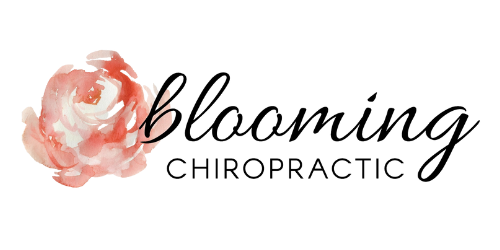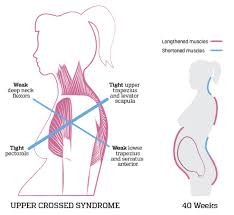What is upper cross syndrome? And how does it relate to pregnancy and postpartum?
Upper cross syndrome is a postural imbalance or musculoskeletal condition that primarily affects the upper body, including the neck, shoulders, and upper back. It typically occurs as a result of prolonged poor posture, such as sitting at a desk for long hours or using electronic devices with a forward head posture.
The syndrome is called "Upper Cross" because it involves two sets of muscles that form an "X" or cross-like pattern when viewed from the side. These muscle groups become either tight and overactive or weak and underactive, leading to the characteristic postural changes and symptoms.
The key features of Upper Cross Syndrome include:
Forward Head Posture: The head is positioned forward of the natural alignment of the spine.
Rounded Shoulders: The shoulders roll forward and inward, causing the chest muscles to become tight and the upper back muscles to weaken.
Tight Chest Muscles: The pectoral (chest) muscles become tight, contributing to the rounding of the shoulders.
Weak Upper Back Muscles: The muscles in the upper back, particularly the rhomboids and lower trapezius, become weak due to being continually stretched and underused.
Tight Neck Muscles: The muscles in the front and sides of the neck can become tight and overactive.
Muscle Imbalances: These imbalances can lead to discomfort, pain, and reduced range of motion in the neck, shoulders, and upper back.
Headaches: Forward head posture and muscle tension in the neck and upper back can lead to tension headaches.
But how does upper cross syndrome relate to pregnancy and postpartum?
Upper cross syndrome is commonly seen among pregnancy due to the changes that occur in the body while pregnant such as enlarged breasts, including alterations in the center of gravity and hormonal changes affecting ligaments. Upper cross syndrome occurs during postpartum due to prolonged periods of time holding and feeding baby, hormonal changes, muscle weakness and awkward sleeping positions.
How does chiropractic help with upper cross syndrome?
Spinal Adjustments- help reduce tension in the neck, shoulders, and upper back, which are common areas affected by UCS.
Myofascial work-Chiropractors may use soft tissue techniques, such as massage or myofascial release, to relax tight muscles in the upper back, neck, and shoulders. This can help alleviate muscle tension and reduce discomfort.
Postural Correction- Chiropractors can provide guidance on maintaining proper posture and offer exercises and stretches to reinforce good posture habits.
Lifestyle/Ergonomic recommendations- Chiropractors recommend ergonomic modifications, lifestyle modifications, and exercises to help prevent upper cross syndrome.
Make appropriate referrals- Chiropractors can provide a referral to other Heathcare professionals such as physical therapist or acupuncture to help manage symptoms of upper cross syndrome.
If you have any questions, please do not hesitate to contact.
To schedule an appointment, please call or text us at 657-845-1669 or use the online schedular.



